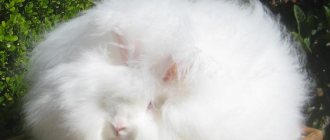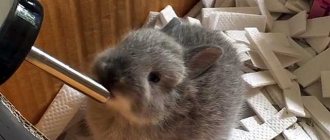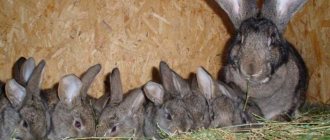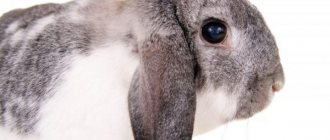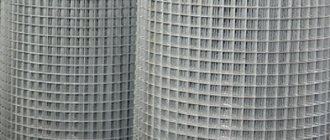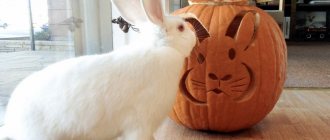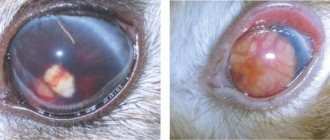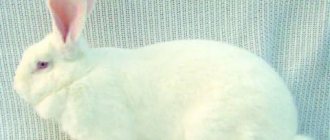Advantages of raising rabbits in enclosures
- Freedom of movement in the open air. This is probably one of the main advantages of enclosures, because few people like to be in a tight, stuffy cage, without sufficient lighting. Rabbits are quite playful animals by nature; they love to run around and jump.
- Economic benefit. To build the structure you will need very few materials. The main material is mesh. The back of a house or barn can become the wall of an enclosure. Also available materials are suitable for construction.
- When keeping a large number of rabbits, an aviary is the best solution. Despite its spaciousness, it will take up much less space than massive cages. According to veterinary standards, one rabbit must have at least 1 m² of area.
- Easier care of livestock and enclosures. For ease of feeding, you can build one large feeder. The enclosure must be cleaned once a week. With the onset of cold weather, you don’t have to worry about the animals freezing, because they are in constant motion in spacious enclosures, which cannot be said about cages. Farmers do not need to constantly monitor the condition of their feed. Rabbits in the fresh air, being in good physical shape, can chew even frozen grass; their digestion can cope with this task.
- Physical state. Rabbits living in enclosures rarely get sick, actively multiply, and gain weight well.
Arrangement
Keeping rabbits without cages is permissible if the appropriate area is properly equipped. The simplest option is an outdoor area fenced with a fence. The size of the enclosure is selected individually based on the number of rabbits. When keeping adult males, it is recommended to choose larger areas, since adults share the territory.
The structure must be located on a hill so that excess moisture after rain and melting snow flows down and does not stagnate. The fence is constructed from mesh, slate, wooden slats, and metal sheets. The fence should be dug into the ground, as rabbits dig holes and are able to escape by digging under the ground. The height of the fence must be at least a meter.
To increase animal activity, it is recommended to leave the floor earthen. This measure also simplifies the care of the animals. A fence made of metal and mesh is treated with special compounds to prevent rust.
There is an option to cover the floor with concrete compounds. In this case, it is necessary to cover the concrete with straw or hay for insulation, and also to cover it with a canopy from precipitation. This method resembles an open-air cage.
Rabbit breeders construct enclosures from barns with dirt floors. It is necessary to ensure that there is sufficient light and ventilation in the barn. The walls of the room are covered with metal or mesh so that animals do not chew the structure. Add twigs to your animal's diet so that the rodent can grind down its teeth.
To create shade, construct a canopy. Containers with food and water are placed under it. It is important to install enough feeders to avoid fights. It is recommended to provide shelters for animals where they can hide from the heat in summer and from the cold and winds in other seasons. For dwarf rabbits, it is necessary to additionally insulate the shelters. One of the design options is considered to be boxes dug to a depth of up to a meter, connected to entrances - pipes that go to the surface.
It is recommended to equip the enclosure with nests for newborn rabbits. If the female does not dig holes and build a nest on her own, she will use a ready-made structure. When keeping pregnant females together with other individuals, it is recommended to divide the enclosure into a queen cell and a feeding part. When kept in this manner, rabbits reproduce better than in cages, so it is necessary to monitor the condition of the babies and timely separate individuals of different sexes.
General requirements for rabbit enclosures
Rabbits are quite capricious, therefore, before starting to create a run, the breeder must become familiar with the conditions and requirements for enclosure keeping.
The first to move into a new paddock is a female rabbit with her cubs or young animals of the same age. The proximity of animals of different sexes, young animals and adults is fraught with showdowns and even fights. Therefore, you should not place them in the same enclosure. It should also be borne in mind that incest among rabbits is prohibited.
Conflicts between rabbits should not be allowed. Fights harm the condition of the fur coat and can lead to the appearance of open wounds through which the animals can easily catch an infection.
It is recommended to house sexually mature animals of different sexes separately from each other. It is not necessary to build separate paddocks for males and females - you can simply divide the enclosure into compartments and separate them with durable material (for example, chain-link). In addition, it is important to take care of the mating compartment in advance. You also need to prepare a separate corner in the enclosure where the female rabbit and her litter will move after giving birth.
Young mothers with rabbits living together in the same room quickly cease to distinguish between their babies and strangers, which is why they feed all the babies indiscriminately. You should not try to correct this system - it is important for the health of the rabbits. Many breeders purposefully “mix” rabbits from different litters among themselves. The so-called mixed feeding system promotes:
- improving the quality of fur coats;
- formation of strong immunity and health in general;
- rapid growth and weight gain.
The enclosure must have a roof. Rabbits jump high - a roof is needed to prevent their escape. In addition, it will protect animals from attacks by predatory animals (foxes, martens, cats, dogs, etc.). Chain-link and roofing material are suitable for the roof. The latter serves as an addition to the net to protect the animals from precipitation.
Another nuance is the need to create a reliable floor. It is better to prefer concrete or wood. An earthen floor is possible, but in this case the walls must be recessed into the ground by half a meter. Rabbits are excellent diggers and these measures are needed to prevent them from escaping through a tunnel.
Summer enclosures that provide comfortable keeping of rabbits outdoors must meet the following requirements:
- have sufficient area at the rate of 1–1.5 m² per individual;
- build on a hill to eliminate the possibility of flooding;
- the walls of the structure must provide access to air and sun - a chain-link mesh is ideal for this;
- There must be a canopy under which the animals will hide from the sun - this can be the entire roof, or only part of it;
- the walls must be at least 1 m high, since rabbits can jump quite high;
- the mesh should be chosen with small cells, otherwise the animal may stick its head into it and get stuck;
- for ease of feeding and cleaning, the enclosure must have doors;
- It’s good if the fence is combined with a barn where rabbits live in winter.
An ordinary enclosure is not suitable for a decorative rabbit. It is better for him to build a small portable house with a roof, which can be taken out onto the lawn during the day and brought into the house at night.
Pros:
- conditions closer to natural, this has a positive effect on the appetite and mood of rabbits;
- They also reproduce willingly under these conditions;
- when kept in enclosures, animals almost never get sick;
- it's economical. Less building materials are needed for the construction than for individual cells. And building an enclosure is simple and takes little time; it can be done in half a day;
- space is saved. Many animals can live in one enclosure. If you make a personal cage for each of them, then you will need many times more square meters;
- You can feed and water all the animals at once by pouring them into a common feeder and pouring water into one large drinking bowl. Also, when kept in an enclosure in the summer, rabbits can eat grass that grows in the enclosure;
- ease of care: the enclosure needs to be cleaned less frequently than cages. It is possible to make such an enclosure at your summer cottage, caring for rabbits only on weekends;
- if you use sawdust for bedding, you get good fertilizer;
- protection from attacks by rats or other predatory animals. The rabbit family in a crowd will be able to fight back and protect their offspring.
There are many advantages to keeping rabbits in an enclosure.
Minuses:
- seasonality of such content. For the winter, all the livestock will either have to be slaughtered or moved to a warmer room;
- vulnerability to infections. If one of the herd gets sick, all the rabbits are more likely to die;
- This type of housing is not suitable for rabbits of large meat breeds, because implies physical activity. Rabbits kept in cramped cages are fattier and have more tender meat due to underdeveloped muscles;
- different female rabbits can give birth in one place, and later rabbits may die;
- A rabbit accustomed to an enclosure can also die if it is transplanted into a cage.
Weigh all the disadvantages before making a decision
The main question associated with keeping rabbits in enclosures is whether they are better than cages or not. Compared to the latter, enclosures provide animals with significantly more free space and save space.
Did you know? The pads found on rabbits' feet are used to produce sweat.
- Advantages of keeping rabbits in enclosures:
- a more economical option compared to cages - fewer resources are required for construction and operation;
- The feeding process is greatly simplified - all that remains is to monitor the filling of the feeders and drinkers;
- sawdust used as bedding can later be used as fertilizer;
- has a positive effect on the mood and appetite of animals;
- improves the reproduction of rabbits.
Minuses
- Disadvantages of keeping rabbits in enclosures:
- aviary housing is not suitable for meat and meat-skinned breeds, since it negatively affects the quality of meat;
- in such conditions the infection spreads much faster;
- enclosures are not suitable for winter, and animals need to be relocated somewhere;
- high probability of fights and random incidents.
To know how to keep rabbits in enclosures, it is worth remembering the nuances:
- it is important to ensure that the feeders and drinkers are full, and that the food and water in them are clean and fresh;
- It is necessary to include wormwood and walnut leaves in food to prevent helminthiasis and coccidiosis;
- Once every 2-3 months, disinfect the living space of rabbits. A decoction containing alkali and camel thorn is quite suitable for this purpose;
- Animals of approximately the same age should be kept together;
- males and females are kept separately to prevent uncontrolled mating.
Enclosures do not provide for year-round keeping of rabbits. The most favorable option for animals will be to move to a heated room, but such an opportunity is not always available. The solution to this problem is to insulate the entire space of the enclosure (especially the house) with a dense layer of hay - the animals will use it as natural insulation.
You also need to increase the volume of portions and serve only warm water. A rabbit enclosure may well become a decoration for your dacha. By providing rabbits with free space to roam, it gives owners the opportunity to admire the animals themselves.
Advantages and disadvantages of keeping rabbits in enclosures
An enclosure is a space fenced with a mesh intended to house animals. It is often built for poultry or livestock, but rabbits can also live in a similar open-air structure. It is only important to observe the specifics of calculating the recommended area - per rabbit there should be from 0.7 to 1 sq. m of free space.
The advantages of keeping rabbits in cages include the following factors:
- living in wild conditions helps improve metabolism, better metabolism, normalization of the cardiovascular and digestive systems;
- due to improved health, the percentage of survival and birth rates increases;
- the emotional state of rabbits noticeably improves - aggression is replaced by calm behavior;
- there is room for free activity of animals - now they can run, strengthening the muscle structure of the body;
- Appetite noticeably improves, facilitated by fresh air and increased mobility;
- due to free movement, rabbits can eat frozen grass - it will have a positive effect on the digestive tract;
- It becomes easier for livestock breeders themselves to clean the places where rabbits stay;
- females stop dividing the cubs and feed the entire brood with milk - this has a positive effect on the rapid strengthening of their immunity and growth.
Despite the listed positive features, aviary maintenance has some disadvantages:
- if an infection enters the enclosure, all individuals become infected at once;
- due to the rapid gain of muscle mass through a good appetite and increased activity, rabbit meat becomes a little tough;
- if a rabbit breaks out, it is almost impossible to catch up with it;
- if breeders prefer to keep several breeds, each variety needs to build its own enclosure;
- It is necessary to place traps and other traps around the perimeter to protect against predators - you can limit yourself to erecting a fence of thorns or barberry along the perimeter of the entire suburban area.
To prevent rabbits from escaping from the enclosure, it is necessary to erect a fence made of mesh or a fence 1.5 meters high. Additionally, the fence is dug into the ground to a depth of 40 cm or more. If the rabbit breed is larger than average, the height of the enclosure fence should be increased.
Main characteristics
To arrange the enclosure, it is necessary to select a sufficiently large area. It is advisable to choose areas that are as flat as possible, without slopes or any hills or lowlands. In general, a rabbit enclosure is an open area located directly on the ground and fenced on each side with chain-link mesh.
Note! An important element of the enclosure design is the canopy, which will protect the animals from direct sunlight and the invasion of uninvited guests.
Design parameters for breeding animals depend on their number. For example, an area of 25 m2 will allow you to raise from 25 to 30 rabbits at the same time.
The most suitable place for organizing a pen for rabbits in the country is the area adjacent to the barn. One of the walls will serve as the end wall of the barn. It is near it that houses for rabbits should be located.
Content Features
Aviary maintenance requires compliance with certain conditions for breeding rabbits.
General recommendations
General recommendations for keeping and caring for rabbits in an enclosure include the following:
- Enclosures should not be compacted with animals - this will lead to their aggressive behavior and fights;
- It is not recommended to introduce new individuals into an established enclosure - a newcomer will not be able to get along with other individuals; in the same way, females that have hatched are not combined;
- young animals are allowed to be placed in an open-air enclosure only when they reach three months of age;
- if one animal is sick, it is required to move it into a separate cage until complete recovery;
- Males and females should be combined, taking into account one male for 5-10 females.
See also How to make a rabbit cage with your own hands using Zolotukhin technology?
It is allowed to keep males in one enclosure, but its area should be 1.5 square meters. m per individual. You should not be surprised if the males start fighting - they cannot be stopped, since such actions will provoke even greater aggression. Fights will occur between males in the first 1-3 days - during this time the individuals will divide the territory.
Features of keeping rabbits in an enclosure in winter
It is not recommended to keep rabbits in open-air enclosures in winter. In particular, it is forbidden to relocate mature young animals in winter - for this you need to choose late spring or summer. It is better to move the enclosure indoors before the thaw.
The features of keeping rabbits in enclosures in winter include the following points:
- if the enclosure is moved indoors, it should be well covered and, if possible, insulated;
- in regions with a harsh climate, it is recommended to organize additional heating of the room where the enclosure will be moved for the winter;
- a lot of straw should be laid on the floor, which is changed as necessary;
- if necessary, mesh fences are covered with sheets of plywood or other dense material that rabbits cannot chew through (it is prohibited to use foam rubber and other fabric products);
- it is necessary to organize good ventilation and penetration of natural light in the room: it is enough that the room has operable windows that can be opened slightly during the daytime sunny time to ventilate the bad smell;
- young animals will not be able to survive the harsh winter even in a heated room, so they should be placed in cages located at home (in the entryway, on a heated veranda).
If it is not possible to equip the animals with a high-quality heated room, it is recommended to slaughter all the young animals for the winter, leaving only hardy adults.
Keeping rabbits in enclosures in an apartment
If space allows, in apartment conditions you can also keep small rabbits or their decorative varieties in an enclosure. The use of such structures should be in compliance with the following recommendations:
- for reproduction in the apartment you will need more space - at least 2 square meters per individual. m;
- it is required to let the animal out for a walk around the apartment;
- It is forbidden to ventilate the room in cold weather - decorative rabbits are prone to frequent colds;
- It is not recommended to place the enclosure near a window - animals do not like direct sunlight entering their home and constant changes in lighting;
- It is prohibited to install the enclosure near a radiator or any other heating device;
- the structure should not be placed near a cluster of wires - animals can reach the dangerous area and chew the wires;
- a rug or any other soft material is laid on the floor of the structure.
A rabbit can get bored in an apartment. To prevent this from happening, you should place various entertainment devices in the fence: tunnels, toys, houses.
Types of enclosures
Enclosures are divided into one-, two- and three-tier. The first ones occupy one “floor”, but a vast area due to their dimensions. Two- and three-tier ones are smaller, since the space is taken into account not in width, but in height, and they also have a rather complex design due to the presence of transitions between tiers.
Separately, there are models designed for pregnant females. They are divided into feed and uterine. In the first, the female and newborn rabbits are resettled separately from the rest of the livestock for rearing, in the second - for inspection of the female and rabbits (performed as an extension to the main enclosure).
Did you know? Rabbits can accelerate up to 56 kilometers per hour.
Types of enclosures and their characteristics
The following types of enclosures for keeping rabbits are distinguished:
- one-, two-, three-tier - such structures require the presence of several floors, interconnected by homemade stairs;
- structures for normal stay are a fenced space with a house, a feeding trough, a drinking bowl and other devices;
- the structures where pregnant females are kept are a fence without additional structures (an insulated section is sufficient for an overnight stay), since it will be difficult for a pregnant individual to move up the stairs;
- designs with a uterine compartment - it is necessary to allocate an insulated and closed place so that a pregnant female can give birth in a timely manner and place her babies in a safe and warm place (uterine chamber). Read more about how to make a queen cell with your own hands here;
- an enclosure with a feeding compartment - a special additional fence where feeders are placed, which simplifies cleaning in the enclosure;
- structures with access to a pit - the pit can be intended for animals to spend the night or become a kind of tunnel for access to an additional “home” fenced area.
See also What to do if rabbits chew wooden cages, and why does this happen?
In the latter case, the area should be sown with fresh grass, which is constantly maintained by pulling out weeds. At the exit or entrance of the tunnel there should be a door that should be closed at night so that the rabbits spend the night in their houses.
How to build an aviary with your own hands
Building an enclosure is not a particularly complicated process, and anyone can design it themselves. Below is a detailed construction experience.
Size calculation
The area of the structure is calculated based on the formula: one animal per square meter. The optimal height is one and a half meters.
Important! In their natural environment, rabbits live in burrows. In enclosures, they also like to create a developed underground shelter system. In this regard, it is recommended to provide them with as much soil as possible.
For work you will need the following tools and materials:
- slate;
- metal grid;
- tree;
- polyethylene film;
- mineral wool;
- support pillars;
- hammer;
- nails;
- shovel.
The process occurs in several stages.
Construction of a fence does not require any special knowledge or skills. From a minimum set of materials, anyone can independently build a functional home for long-eared animals: a simple, multi-tiered, winter or portable enclosure. Next, we’ll look at how to build a simple structure for keeping rabbits outdoors.
What should be inside the enclosure
Inside the building there must be:
- canopy;
- cages or houses for individual recreation;
- large feeder and drinker;
- hay fields;
- pits and shelters for animals.
Small portable enclosure for ornamental animals
Free keeping of rabbits is a very promising and effective walking method of breeding and raising them in open space. Such a structure can only be made in a country house or in a private house. It’s difficult to do something like this in an apartment. Cage-free housing is an ideal option for a start-up business that helps raise rabbits quickly.
Wooden aviary for rabbits
A combination of cage and kennel housing can provide greater weight gain for rabbits than being kept in a fenced outdoor kennel. To assemble a wooden enclosure, you need to make several booths from chipboard.
During construction, you will also need several galvanized sheets to make the upper floors of the boxes. The enclosure will be multi-tiered. Rabbits can chew through the wooden ceiling of the tier, and the metal roof of the cage will not allow animals to damage the structure.
Each wooden box is lined with metal mesh on the outside. Holes for rabbits are cut out in the side wall of the box. The tiers of the enclosure are connected to each other by boards on which transverse strips are nailed so that the animals can move freely along the tiers.
The floor in the enclosure is made of boards, which are installed on bars 5 cm high to ensure air circulation. The distance from the wall to the system of wooden houses should also be 5 cm.
The enclosure is fenced with a wooden side, the height of which is 20-25 cm. Thus, a small walking area is set up for the animals.
A powerful fan is installed in the room, which is connected to the air circulation system. If you plan to keep rabbits in an enclosure not only during the warm season, it is necessary to provide air heating.
Place feeders in the common walking area. Using hopper feeders will save you a lot of time. Also install a hay barn and a salt shaker in the enclosure so that the animals receive the necessary microelements.
Making an enclosure for rabbits with your own hands is more difficult than setting up a fenced walking area. Wooden construction also has its advantages and disadvantages. The advantages of an enclosure for rabbits include:
- the possibility of its installation in a small area;
- large capacity;
- reduced risk of coccidiosis infection;
- Possibility of keeping rabbits in an enclosure all year round.
Since rabbits are kept in a tiered system connected by wooden passages and manholes, the likelihood of the animals becoming infected with coccids is minimal. When installing a feeder in a walking area, feces also remain outside the boxes. Cleaning is carried out every two days. Each enclosure box has a separate door for easy cleaning.
The disadvantages of a wooden enclosure for rabbits include:
- expensive arrangement of the enclosure;
- the complexity of its assembly;
- keeping one family of rabbits in an enclosure.
A wooden enclosure is only suitable for keeping related rabbits that have become accustomed to each other from birth. If you let an adult rabbit from another family into the enclosure, fights for territory will begin. Since the area of the enclosure is small, these conflicts will lead to deaths.
The advantage of the enclosure is that there is no need to build lighting into the wooden cage system. The main energy consumption is for heating the premises.
Rabbits have enough light that enters the room through the windows. The aviary can be installed in a garage or barn. Dim daylight is most suitable for keeping and breeding rabbits.
article: rabbit breeds with photographs, names and descriptions of breeds!
Arrangement of the enclosure
An enclosure for animals is an open space, which is fenced around the perimeter with a special fence. The dimensions of this place depend on the number of individuals. They need to be done on higher ground to avoid flooding. It is recommended to make the walls from any building material at hand. One side should be made of mesh so that the room is ventilated. The height should be about a meter, or even better, one and a half meters, since the animals jump high.
To save money, you can make an enclosure with a dirt floor. Only in this case you need to make protection from the outside so that the pets do not escape. The walls are buried half a meter into the ground, or metal rods are driven in around the perimeter every 10 cm, the length of which should be 1 meter. The earth floor has its advantages - it does not require constant cleaning. In addition, pets can dig minks and develop physically.
The mesh must be treated with an anti-corrosion agent in order to use it longer
The floor can be poured with concrete to make something like a cage, only without a roof. To make cleaning easier, it can be made from mesh. However, not all types of rabbits can be kept on a cellular floor, as they can develop pododermatitis. The concrete surface is insulated with sawdust or dry grass. The area of the enclosure must be covered with a canopy so that the animals are not afraid of precipitation. You can build one large barn for animals or a couple of small houses that are raised above the ground.
The walls of these structures are lined with mesh so that the animals do not sharpen their teeth. It is recommended to keep small rooms in the form of queen cells. To quickly clean the house, you need to make the roof like a mailbox. It is important to provide the entire population with food and water, as rabbits can be aggressive towards each other. They also need to be given twigs, as they like to chew on things. What branches can you give to rabbits? It is best to give twigs of apple, currant and acacia.
Feeding rabbits
The animals feel as if they are free, they do not have lethargy and apathy, they are not aggressive, which has a good effect on the growth and future of the tribe. Even if the rabbits are not kept in cages, a yard for walking is a good way to diversify and improve their lives. They will be less prone to various heart and gastrointestinal ailments, which will have a positive effect on reproduction. Clean air and a lot of movement are the key to a healthy animal. You need to decide initially what is better, placing them directly in an enclosure or letting them out for a walk.
If the creatures are in enclosures, it is important to protect them from bad temperatures. Large boxes that are lined with waterproof fabric are suitable for these purposes. If the fence is small, about 20-26 sq.m., then 30 heads can be placed there, including 5 males and 25 females. Or about 25 heads of young animals. When there is a need to unite rabbits from different places, they are released into the enclosure at the same time, and fragrant grass or some kind of delicacy will remove the smell of “strangers”.
Arrangement of the floor in the enclosure
Three walls are made of mesh, and the fourth is made of slate, wood or tin, so that the rabbits have protection from the wind. The mesh from which the walls are constructed is buried at least half a meter into the ground and treated with an anti-corrosion agent - otherwise animals may dig under it.
The structure itself is located on a hill to prevent flooding in case of rain, and a canopy is installed to protect from direct sunlight. The enclosure can be placed either on the ground or on a concrete pallet. Drinkers and feeders are mounted on the walls to eliminate the risk of them tipping over.
To properly arrange the floor in the enclosure, you need to follow the following recommendations:
- It is advisable to lay a fine mesh net on the floor to make cleaning easier.
- It is necessary to lay thin bars on the mesh, leaving small gaps between them.
- The boards must be laid at an angle of 45º relative to the transverse beams of the fence, otherwise the rabbits may injure themselves. In addition, do not forget that animals will definitely gnaw the tree.
- Before you start building an enclosure, it is generally necessary to prepare a detailed drawing in which the room is divided into living areas, food compartments and drinking bowls. This will make the construction process much easier.
- In specialized stores, you can purchase special plastic ladders for rabbits as a covering, which are laid instead of bars. This will make it much more comfortable for the animals. In addition, cleaning them is much easier, and the process of rotting is not terrible for the material, unlike wood.
Floor in a rabbit enclosure
For experienced livestock breeders with relevant experience, the process of constructing an enclosure will not cause difficulties. But beginners will have to learn the intricacies.
Construction and arrangement of an enclosure
An enclosure is a limited space that is fenced with mesh or other materials around the perimeter. Most often it does not have a roof or is equipped with a canopy partially to protect animals from precipitation.
Accommodation requirements
Before you start building an enclosure for rabbits, you need to choose a suitable place where it will be located. The main requirement for placement is that the enclosure is installed in an elevated place to avoid flooding during rainy periods and melting snow. In the southern regions, farmers recommend installing an enclosure in the light shade of trees to protect their pets from overheating. In the northern regions, they do things differently - housing for rabbits is placed in the open sun.
How to correctly calculate the area of the enclosure?
Having decided on the location, you need to correctly calculate the area of the structure. It is determined based on the number of livestock. On average, each rabbit should have at least 0.7 m2. Rabbits with baby rabbits will need more space. The optimal value is 1 m2 for each adult.
Construction Materials
To build an enclosure with your own hands you will need building materials:
- bars;
- board;
- metal mesh;
- supports (you can use pipes or metal pegs);
- shovel;
- screws, nails;
- screwdriver;
- door hinges;
- lock;
- slate;
- sand;
- sawdust.
Attention! It is important to correctly calculate the perimeter of the enclosure in order to purchase the required amount of mesh, boards and slate. It should be taken into account that the side parts of the enclosure are dug to a depth of at least 0.8 m so that the rabbits cannot dig under the ground and escape.
Construction phase
Having chosen a suitable place on the site to build an enclosure for rabbits, you need to take measurements and draw markings. At the initial stage, a ditch is dug into which the walls of the slate structure will be deepened. Supports are dug into the corners to a depth of 0.8 m. Sheets of slate are placed in the recesses (it is more convenient to use flat slate). They are fastened together. The ditch is filled with earth and compacted, and the site is leveled.
The mesh is attached to the metal corner supports using self-tapping screws. The height of the walls of the structure is 1 m. It is advisable to cover the back of the structure with a board to protect the animals from drafts. A door is installed on the front or one of the side walls.
The top layer of soil inside the enclosure to a depth of 15 cm must be removed, and sand should be poured in its place. A mesh is fixed over the sand layer, onto which sawdust is then poured. Some farmers leave the dirt floor, others concrete it and then insulate it with bedding.
Attention! Not all breeds are able to live on a mesh floor. Heavier rabbits and those with sparsely furred feet will suffer from pododermatitis.
Mandatory attributes of the enclosure are shelters - houses made of wood, where pets will hide when they are cold or scared, and rabbits with litter also need such shelters. It is in them that the birth occurs.
If desired, you can build a small canopy over the structure; it will protect the rabbits from the hot sun, rain and snow. Drinkers and feeders are installed inside the enclosure. It is important to ensure that this equipment meets the needs of the entire livestock, otherwise the rabbits will fight for food and water. You can move eared animals into your finished home.
Construction of an enclosure-pit
In order to build an enclosure for rabbits with your own hands, you need to fence the enclosure area with a net. Slate is dug along the perimeter of the enclosure along the mesh so that the rabbits do not dig passages out. Sheets with a height of 40-50 cm are used, since animals do not dig holes of greater depth.
Inside the enclosure you need to place feeders with grain and hay, as well as nipple drinkers. Sparrows or other birds may flock to feed, which will increase the risk of animals becoming infected with viral diseases. To avoid this, cover the top of the enclosure with a net. This will also keep rabbits safe from dogs and cats.
This simple design is suitable for summer keeping rabbits. Females can be placed in the enclosure. Males are placed in a separate area to control the breeding of rabbits.
There will be fights among males in the first days of cohabitation. When the territory is divided and a hierarchy is established, conflicts will stop.
Rabbit enclosures covered with chain-link mesh allow too much light to enter, making the animals feel uncomfortable. Therefore, it is necessary to install wooden booths with a dirt floor or canopies in the enclosure, which will provide shade inside the open space. It is in shaded areas that rabbits will dig holes.
article: what to feed rabbits in winter at home?
A fenced-in rabbit run area has its advantages and disadvantages. The advantages include the following features:
- It is easy to care for animals in such an enclosure and monitor their health;
- the fenced enclosure is well suited for mating animals;
- it is easy to clean in the open walking area, since the floor remains earthen;
- In the enclosure, the conditions for keeping rabbits are close to natural, the animals develop strong immunity, so they get sick less.
The disadvantages of the walking area include:
- lack of queen cell;
- increased consumption of feed for fattening animals;
- slow weight gain in rabbits.
Unlike cage housing, it is difficult to arrange a queen cell for baby rabbits in a fenced walking area. Without a separate queen cell, adults can kill the offspring, which makes it difficult to breed rabbits in an enclosure.
Using only hay and grain to feed rabbits, you will not be able to get good weight gain. Giant rabbits, for example the Gray Giant breed, need to be fattened for meat for at least 6 months, using expensive feed. Otherwise, rabbits will not gain weight.
Therefore, keeping rabbits in an enclosure with a fenced walking area is unprofitable. This enclosure is more suitable for keeping downy breeds of rabbit.
This is what a house for a two-tier rabbit enclosure might look like. Schematic representation of an enclosure for keeping rabbits in winter.
Aviary care
Timely hygiene is the prevention of most diseases in rabbits.
It is necessary to clean the enclosure weekly, removing waste and treating it with special veterinary agents that prevent the growth of bacteria.
Make sure that the hay and sawdust in the enclosure are always fresh and do not allow them to rot.
Change the water in the drinking bowls regularly, making sure that it is always in the required quantity.
Feeders and drinkers for rabbits
Types of feeders for rabbits:
Bowls Hopper Chute Nursery
- Bowls. You can take regular dishes, but active rabbits can easily turn them over.
- Bunkers. This design of the feeder prevents food from being scattered throughout the enclosure; food is poured there once every couple of days.
- Gutter This feeder is easy to make and several rabbits can feed from it.
- Nurseries. Used for hay.
Types of drinking bowls for rabbits:
Bowl Cup Vacuum Nipple Automatic
- Bowls. You can take regular dishes, but, just like with feeders, rabbits can turn them over, which can lead to dampness and mold in the enclosure. And the rabbits themselves will be thirsty.
- Cupped. They are made from bottles and have a fairly large volume.
- Vacuum. Can also be made from plastic bottles. The water in such drinking bowls stays fresh longer.
- Nipple. Special drinking bowls with a ball at the end. The rabbit drinks by pressing the ball with its tongue. The most versatile type of drinking bowls for rodents. Water does not flow out of such a container on its own, does not evaporate, and the rabbit cannot turn it over. Disadvantages can only occur in winter, when the ball freezes.
- Automatic. Drinkers for large farms. From a large container, water is automatically supplied through tubes into the enclosure.
Construction of an aviary
First of all, you need to make sure that the enclosure is spacious and light. It is recommended to leave the floor earthen.
Required building materials:
- Support pillars. They can be made of metal, wood or plastic. Their main quality is high strength. The part of the support that you will subsequently dig into the ground must be treated to prevent rotting or corrosion.
- Net. It can be a chain-link or plastic, wooden or metal rods are possible. But it is necessary to take into account the size of the holes in the mesh so that the rabbits cannot crawl out through them.
- Boards or corrugated sheets for a canopy.
- Wooden houses or boxes with an opening top and an entrance for rabbits. When kept in winter, they need to be insulated with sawdust, rags or polystyrene foam.
- Shovel.
- Fasteners corresponding to the selected materials (nails, screws).
- Fastening tools (hammer, saw).
An enclosure requires a lot of building materials
Selecting a location:
- The main quality of the chosen location is an elevation or slope to prevent flooding of the enclosure.
- The second important quality is the availability of the necessary free space for comfortable walking of animals. The measurement is made at the rate of 1-1.5 m per adult.
- There are no enclosures with birds or other animals nearby.
The enclosure must have a canopy that protects from precipitation
The first step is to install the supports for the enclosure. At a pre-selected location, fence off about 20 meters for the enclosure.
Install supports
Dig holes for the supports and add a small amount of crushed stone to the bottom.
Dig holes
The end of the support, which will be in the ground, must be treated against corrosion or rotting.
Treat the end of the support
After installing the supports in the prepared recesses, fill them with soil or fill them with concrete prepared in advance.
Support filled with concrete
From support to support, a trench is dug for the walls of the enclosure, deep enough so that the rabbits do not dig under.
Dig a trench
A mesh is stretched over the installed supports, or wooden beams are nailed. The net or bars must be dug into the ground to prevent the children from running away.
Stretch the mesh over the supports
The door to the enclosure is separately covered with mesh and mounted.
The door to the enclosure also needs to be covered with mesh.
A roof is made over the fenced enclosure. Some are also made of mesh or beams, and some need to be covered so that the animals can hide from bad weather or direct sunlight.
Make a roof over the enclosure
In a ready-made enclosure, wooden houses or boxes are placed for the rabbits to raise their offspring.
Set up houses for rabbits
Step 10
Also in the enclosure there should be drinking bowls and feeders, in quantities corresponding to the number of rabbits. They need to be secured so that active rabbits do not turn them over.
Don't forget about drinking bowls and feeders
Table 1. Types of feeders for rabbits
Water and food should always be fresh
Table 2. Types of drinking bowls for rabbits
What should the enclosure be like?
Aviary keeping of rabbits
An aviary for rabbits has the following characteristics:
- Typically, to keep up to 30 rabbits, it is necessary to fence off 20 square meters of open space, located on a small hill, so that moisture does not accumulate.
- The fence can be either wooden or made of mesh materials.
- The ceiling height should be at least one and a half meters, as rabbits can jump very high.
- The walls should be dug deeper into the ground to avoid undermining and escape of the wards.
- The floor of the enclosure remains earthen , this is more familiar to animals; they will be able to dig holes, as in the wild, and also feast on fresh growing grass. If it is impossible to leave the floor earthen, it must be carefully insulated with hay or sawdust in sufficient quantities so that animals can burrow there in case of cold weather.
- Some part of the enclosure should have a roof to provide shelter from precipitation; you can also build houses where rabbits can shelter in bad weather and bring offspring. For ease of cleaning, the roof of such a home is made to open.
“The enclosure should not have any nooks and crannies where it would be difficult for a person to get into. Rabbits can climb somewhere, they can even die there. Therefore, it is necessary that all places are visible and accessible, so that you can easily get into them” (rabbit breeder I. Stepanov).
Breeding rabbits in an aviary
If you are going to breed rabbits in an enclosure, then you should adhere to the following recommendations:
- When the enclosure is ready, it is necessary to populate it correctly. All the rabbits are released there at once, subsequently they will be replenished with rabbits born there;
- But it’s better not to add strangers to an already formed family - they won’t accept you;
- with the exception of females, which are kept separately from males, joining them only for the purpose of reproduction. Males are not placed with females;
- a day after mating, a “control” mating is carried out so that the rabbit definitely becomes pregnant;
- when the goal is achieved, the males again settle separately. Female rabbits raise their offspring for up to three to four months, after which new males emerge from the offspring and also breed;
- female rabbits kept together are friendly to both their own and other people’s offspring, if it smells “familiar”, the females can feed all the rabbits of the herd;
- male rabbits need to be separated and in order to prevent a double pregnancy of the female rabbit, their body is designed in such a way that this is possible, but such offspring will be smaller and less viable;
- for breeding, female rabbits need queen cells - artificial burrows, which can be replaced with boxes or special houses with an opening roof;
- Mating between blood-related rabbits (father-mother-son-daughter-brother-sister) should not be allowed; the offspring may be unhealthy;
- if you breed rabbits for sale, cross only one breed of the same color; animals of different colors are not considered purebred.
At one time, a female rabbit can bring 6-14 rabbits
Large breeds – 8 months female, 9 months male.
Medium breeds – 6 months female, 7 months male.
Small breeds – 5 months female, 6 months male.
The gestation period lasts about a month. A female rabbit can give birth to healthy young rabbits up to three or four years of age.
Winter keeping of animals
During the winter season, cage-free keeping of rabbits requires special attention. It is necessary to create comfortable conditions:
- The habitat of the animals is insulated and isolated from drafts.
- Additional heating devices are used.
- Additionally, hay or other insulating material is placed on the floor; it is recommended to raise the surface above the ground.
- Install a ventilation system and lighting fixtures.
Cold has a negative impact on the health of young animals, so it is recommended to place the babies in a warm room or send them to meat. Mesh walls are insulated with sheets of plywood. It is recommended to additionally insulate the canopy and roof.
Advantages of an aviary
In addition, the enclosure allows the rabbits to move more, as a result of which the animals are less susceptible to all sorts of diseases. Many people refuse vaccination altogether.
The enclosure needs to be cleaned extremely rarely: only a couple of times a year. It is convenient to feed the rabbits brushwood from branches: it does not get stuck in the cage and there is enough space. And the females care for the young together, without dividing the offspring into theirs and those of others, while it can be problematic to transfer young rabbits from one cage to another and to another female. A common pen significantly increases the chances of survival of young animals.
Rabbits in enclosures get sick less often, but if they get infected, they usually all die. Whereas when kept in cages, only those individuals that are in the same cage get sick. This can be explained very simply: in the enclosure the feeders and drinkers are common, but in the cages they are almost individual.
Therefore, before moving rabbits into the enclosure, it is necessary to carefully check each animal for any diseases in order to exclude the possibility of infection of all individuals.
The meat of animals raised in open-air conditions is coarser due to more developed muscles and has a pronounced red tint. The meat of caged rabbits is “marbled” in color, which is a big selling advantage. Therefore, it makes sense to build both enclosures and cages that will house those animals that are raised for slaughter.
Arrangement of the enclosure
The rabbit enclosure must be placed on a hill to avoid flooding during rains and melting snow. Ignoring this fact often causes not only illness, but also death of animals.
Any material for the walls of the enclosure is suitable: wood, slate, tin, etc. However, a net is more often used, since the pen must be well lit and ventilated. It is important that the cell is not too large.
Part of the enclosure should be covered with a canopy. This is necessary to protect animals from bad weather. In addition, you need at least one closed wall so that in windy weather the rabbits can hide from drafts. Near this wall you can place “houses” in which animals will either hide or build nests. The house can be shared, but with several entrances.
To prevent rabbits from undermining the fence, the mesh is deepened into the ground at least half a meter, treating it with an anti-corrosion agent. Iron rods driven into the ground will provide additional protection. The most optimal wall height is one and a half meters.
Sometimes the floor of the enclosure is poured with concrete, sprinkled with a layer of sawdust. Sawdust accumulates and over time an “earthen” crust forms, in which rabbits can later dig holes. But this option is more like a large cage, but the possibility of the animals escaping is excluded.
Breeding rabbits in an aviary
Rabbits often dig holes to make nests. It is better to take care of this in advance by preparing several so-called queen cells. Males are kept separately to control the breeding process. In addition, rabbits often fight among themselves, which is also the reason for their living separately. Males are released only when mating is necessary. Breeding rabbits in enclosures does not require special preparation and usually does not cause difficulties.
Females are ready to breed at the age of 5 months, males - at the age of 6-8 months. The rabbit is released into the enclosure for several days, after which it is removed to a separate room. There is no need to remove young animals: rabbits of different ages get along well with each other.
The grown offspring are gradually knocked out. First of all, it is necessary to get rid of the males so that inbreeding does not occur. This is usually done when they reach 5 - 6 months.
Who is the aviary suitable for?
The aviary is most popular among summer residents. Animals can be visited only once a week: during this time nothing will happen to them. In addition, this type of housing is ideal for those living in areas with a warm climate, as well as for raising animals for meat and for temporary housing.
After the spring-summer season, the rabbits are knocked out either completely or only part of them, and the rest are transplanted into cages. Keeping an aviary in winter is undesirable, but possible. In this case, the animals will freeze and get sick, unless, of course, some measures are taken in time, for example, to insulate the pen.
The most optimal option is cage housing, but this depends on the size of the area, the capabilities and goals of the rabbit breeders.
Reviews about breeding rabbits in an aviary
Basic principles of aviary farming
Drawing of a cage for a female rabbit with little rabbits.
The area is calculated based on a simple condition: comfortable breeding of rabbits in an enclosure is ensured if there is 22-25 m² per female with a litter of 26-30 young individuals. Males are usually kept separately and released only for the mating period.
The arrangement of the territory should take into account the habits of animals. So, rabbits easily make tunnels and can organize an underground passage under the fence. In order to exclude shoots, the fence goes deep into the ground by 35-45 cm. Metal pins can be driven to this depth in increments of no more than 8-10 cm. Some area of the territory must be protected with a canopy - the animals can hide from the rain. If there are concrete platforms on the territory, then it is better to insulate them with sawdust or straw.
A prerequisite is the installation of a sufficient number of drinking bowls and food points. A shortage of water or food should not provoke animals into fights and hostility. Small uterine houses are considered a desirable element of the enclosure.
A type of aviary farming is grazing breeding. Such farms are organized when large areas are available. On the territory of the enclosure, an area is allocated where fodder grass is sown, and the rabbits are released into this field, replenishing the diet with pasture. Oats, clover, vetch, and alfalfa are considered excellent nutritious plants, and in combination with them, dandelion, plantain, and tansy are useful.
Creating an aviary
Scheme of a two-section cage for rabbits.
Several sheds with a raised platform are being erected inside the site. Under this canopy the rabbits will hide from bad weather, so the area under the canopy should provide water drainage. It is more rational to build not sheds, but small sheds that can be used as mother houses. One option is artificial mink. A large box with a removable lid is buried in the ground (for cleaning the mink), and the entrance is made in the form of an inclined wooden pipe with a diameter of 30-35 cm and a length of about 1 m.
What is it?
To begin with, let’s briefly outline what an aviary is. In most cases, this is simply a piece of land surrounded on all sides by a fence - usually made of chain-link mesh. In it, rabbits can run freely, frolic, and play with each other.
But this is the simplest type of enclosure. In some cases, an above-ground enclosure is used. In this case, first a fairly large (usually several tens of square meters) platform is built, elevated above the ground by half a meter or a meter. And they already surround it with a fence around the perimeter. This can be a good option to protect rodents from small predators such as rats or weasels. It is also suitable for areas where minor flooding often occurs - seasonal or after heavy rains.
Sometimes keeping rabbits in a barn is considered. Yes, this is also a completely acceptable option. However, in this case, you need to make sure that the walls of the barn are buried in the ground - otherwise the rabbits will easily dig under and run away.
It is also necessary to ensure good ventilation - rabbit waste smells very unpleasant.
Finally, we must not forget about lighting. Rabbits raised in twilight usually get sick often, become more fearful, which is why they gain less weight. The problem can be solved either by installing a large number of large windows, or using special, fairly powerful lamps.
Setting up an enclosure
After determining a suitable location and establishing the size of the area, you can begin to work. In general, there are no problems here. Along the perimeter, stakes or metal (with rust protection or reliable waterproofing) reinforcement are driven or dug into the ground. The quantity depends on the size of the area. For example, if it has an area of about 10 square meters, then you can get by with four stakes around the perimeter. But if you want to get a more spacious area, then the stakes will have to be driven in more often to hold the fence.
The next stage is choosing the appropriate material for the fence. However, in the vast majority of cases, experienced rabbit breeders and beginners prefer conventional chain-link mesh. On the one hand, it is cheap. On the other hand, installation is not particularly difficult; the entire installation can be completed in half an hour or an hour. At the same time, it can serve the owner for many years without needing repairs. Especially if there is a zinc coating that protects the mesh from contact with moisture and, accordingly, rust. However, you can also take ordinary boards, plywood or corrugated sheets. But in this case, be prepared for the fact that in a strong wind, the fence may well be torn out of the ground along with the stakes. Because of this, rabbits may get hurt or simply run away in different directions. And in general, the process of erecting a fence becomes much more complicated.
When the material is selected, you will have to work with a shovel. The fact is that rabbits love to dig holes and all kinds of tunnels. Therefore, digging a path under an ordinary fence will not be difficult for them. To prevent this from happening, you need to deepen the fence. Usually 50-80 centimeters is enough. Dig a narrow trench around the perimeter of the future paddock and install fencing material.
The future fence should rise no less than a meter above the ground. This is quite enough - on the one hand, the rabbits will probably not jump over it unless absolutely necessary (for example, if a predator does not enter the pen), and on the other hand, material is saved, and besides, you can feed the animals without going inside. Of course, at such a height it is quite possible to refuse to install doors.
The material is securely attached to the stakes (or, if you chose something other than a mesh) to cross bars.
It wouldn't hurt to install a few boxes here. Here the rabbits will be able to spend the night until they dig holes for themselves. And also hide from the wind and bad weather.
That's all! The pen is ready and you can move the first inhabitants into it.
